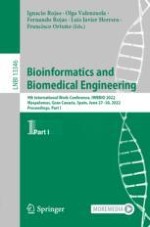2022 | Buch
Bioinformatics and Biomedical Engineering
9th International Work-Conference, IWBBIO 2022, Maspalomas, Gran Canaria, Spain, June 27–30, 2022, Proceedings, Part I
herausgegeben von: Ignacio Rojas, Prof. Olga Valenzuela, Prof. Fernando Rojas, Assoc. Prof. Luis Javier Herrera, Francisco Ortuño
Verlag: Springer International Publishing
Buchreihe : Lecture Notes in Computer Science
